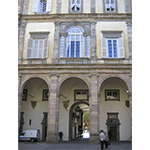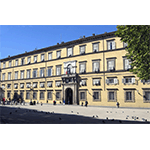Accademia Lucchese di Scienze, Lettere ed Arti [Lucca Academy of Science, Literature and Art]
The Accademia Lucchese di Scienze, Lettere ed Arti originated from the "Accademia degli Oscuri", a mainly literary association, founded in Lucca in the second half of the 16th century by Giovan Lorenzo Malpigli on the model of the "Accademia degli Intronati" in Siena. "But", writes Vincenzo Torselli in 1755, "while retaining the exercises in eloquence and poetry, [...] they decided to focus on the physical sciences, and on illustrating Italian history [...] The Accademia degli Oscuri travelled at length, hither and thither, received in the palaces of those noblemen most interested in its conservation, and had no permanent location until after 1780, when it occupied the largest hall in the former monastery of San Frediano, which was renovated for this purpose, and reduced to more comfortable and convenient form."
In 1805, under the rule of Felice Baciocchi and Elisa Bonaparte, the Napoleonic Academy took the place of the "Accademia degli Oscuri". The new society lasted only a short time (1805-1814), but was very active in the sciences and in Italian history. The Statute provided for the Academy to be divided into two classes: the Class of Sciences and the Class of Literature and Fine Arts. As indicated in the Statute, "the Class of Sciences is charged with collecting all of the new discoveries. It is concerned with the means whereby the State may benefit from those among them that can contribute to its prosperity. It will correspond with scientific societies. It will be composed of 16 members, selected from among men versed in the different fields of some of the Mathematical and Physical sciences." In reality, the original project was abridged and the two classes were consolidated. In the scientific field the Academy, although not achieving all of its ambitious objectives, could boast among its corresponding members scientists of the highest standing, such as the mathematicians Joseph-Louis Lagrange and Gaspard Monge, the astronomer, mathematician and physicist Pierre-Simon de Laplace, the astronomer Giuseppe Piazzi, the physicists Alessandro Volta and Jean-Baptiste Biot, the chemist Claude-Louis Berthollet, the naturalists Paolo Mascagni, Giovanni Fabbroni, Alexander Humboldt, among others.
With the Restoration, the Academy resumed its old name and later, under Duchess Maria Luisa of Bourbon, it was called the "Reale Accademia Lucchese di Scienze, Lettere ed Arti". In the following years the institution carried out intense cultural activity, especially in the field of Italian history. Today it is made up of three classes (moral sciences; physical, mathematical and natural sciences; the arts) and – as stated in the Statute – "it proposes to cooperate in incrementing the sciences, literature and the arts with special regard to the Lucca region and its history." Today the Academy is located in the extraordinary complex of Palazzo Ducale, while its library is on loan to the Biblioteca Statale di Lucca.
****************************
Texts by Graziano Magrini
English translation by Catherine Frost
Last update 20/feb/2008





